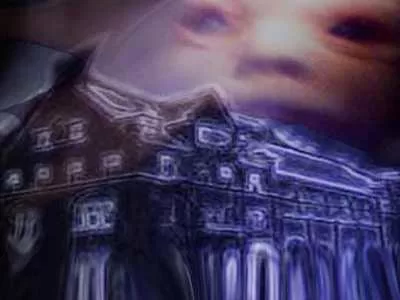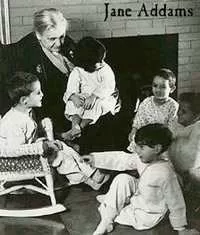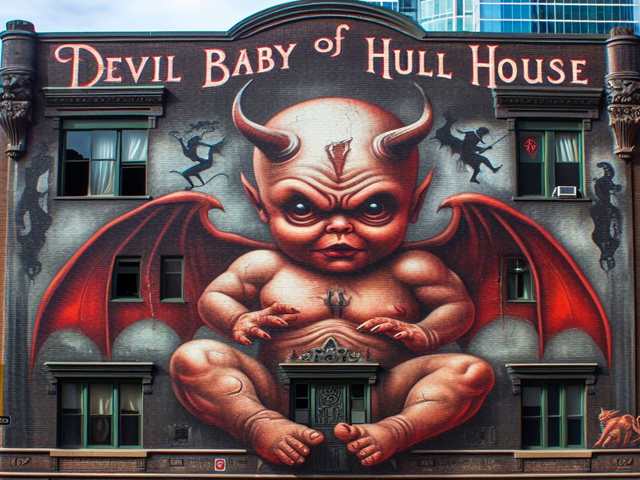Table of contents
Many a tale of horror is associated with that of Jane Addam’s Hull House, One of America’s most famous haunted houses. Founded by Jane Addams in 1889 on Chicago’s Near haunted West side, this now world famous social settlement has become a museum dedicated to Jane Addams and her many works.
The house is in a community where, long ago, immigrants fought in the streets to find their place in Chicago. Hull House is rumored to be the most haunted place in the area… Some hear footsteps, voices are often heard, and a cold touch or bump by an unseen specter. The stories told time and again by both staff and visitors.
The most notorious inhabitant of Hull House might be the Devil Baby of Hull House. That is if, in fact, one ever existed. Even though Jane Addams did everything within her power to persuade people, both in person and in print, that this child was just myth, to this day some still believe the Devil Baby remains trapped in the attic of Hull House.
Who was the Devil Baby?
The most famous American Devil Baby has to be the Chicago’s Devil Baby of Hull House. At least, this is certainly the most widespread legend.
Hull House represented the life’s work of Nobel Prize winning philanthropist Jane Addams. It was a place envisioned as a stepping-stone for underprivileged and impoverished members of Chicago’s poor immigrant society. Because of Addams’ particular interest in suffrage and women’s and children’s rights, it was natural that immigrant women and mothers would be attracted to the beacon of Hull House.
Despite Addams’ fervent denials (she dedicated more than 40 pages to the legend and its impact on her life in her autobiography) the story persisted that Hull House was the home of a creature not of this earth.
Originally, the rumor was just a whisper among the large immigrant population of late 19th century Chicago. Mostly superstitious and uneducated, it is certain that they brought with them from their homelands many ethnic and cultural beliefs that shaped their perception of their new foreign world. However, the “facts” were no fabrication: Most sources agree that Jane Addams, out of charity, took in the female who would bear the burden that would plague the good woman for generations to come.

The mother of the Devil Baby, though nameless, is said to have fled to Hull House to escape a brutal marriage. This is a central part of the story and an important one: evidently the young immigrant woman found herself pregnant once again and the husband, already having too many mouths to feed on his meager income, is said to have ruthlessly beat his wife, all the while cursing the unborn child. When the young woman fled to the shelter of Hull House, she found an understanding matron who was prepared to take her in and to protect her through the difficult pregnancy.
And it was a difficult pregnancy, according to the written accounts of Hull House servants who rendered firsthand descriptions of the notorious events. The mother-to-be complained of unusual pains throughout the pregnancy, of hearing voices and of having vivid, frightening nightmares. Jane Addams and the Hull House physicians put this down to the tormented life that the woman had led prior to escaping to Hull House, exacerbated by the continuous efforts of her husband to gain access to her.
As the time of her delivery came due, the horrible nature of what she had carried and nurtured for nine months was finally revealed. A writhing monster child full of scales and reptilian coldness with gleaming, black eyes, clawed hands and feet, and the protrusions of tiny horns on its forehead.
Legend has it that the mother died on the spot, mercifully released from this world. But in an unexpected turn of events, it is said that Jane Addams was overcome with such compassion that it moved her to take the child into her care.
Thus the story grew up over the years, whispered in every quarter, that behind the walls of Hull House an evil was growing.
This infant grew to a child – a monstrous lump of a human-like creature – that prowled the darkness and had full run of the dreaded third storey of Hull House. It is said that the child would peer from the windows, envious of the other children with whom it was not allowed to associate. Children and other residents of Hull House often awoke in the night to strange scrabbling noises and furtive breathing near their faces, only to discover in the lamplight that they were completely alone.
Eventually, Jane Addams died, but the legend of the Devil Baby of Hull House lives on and even today passersby and visitors to the location report seeing the shadow of “something” childlike peering at them from the darkness.
Devil Baby Facts:
A link between ghosts and cemeteries has a certain logic, but a connection between specters and a monument to good works is less explicable. Nevertheless, a demonic spirit supposedly haunts Hull House, site of the most famous settlement house in America.
In 1889, Jane Addams and another social worker took over the Hull mansion at 800 South Halsted and turned it into a community center. The house, now part of the Chicago campus of the University of Illinois, is currently a museum dedicated to Addams and her work.
Addams was a hardheaded, progressive reformer, a proud and determined do-gooder in an age sorely in need of one. She and her colleagues turned Hull House into a community center, supplying shelter, food and practical advice to the huge number of bewildered young immigrant women in the late 1800s and early 1900s.
In the winter of 1913, Addams could have used some advice herself to deal with what must have seemed to her no-nonsense mind a case of mass hysteria. Women were streaming into Hull House with a very particular request: They wanted to see the Devil Baby. Stories were circulating throughout the city about a child born with scaly skin, horns, hooves and a tail. Some of the rumors included accounts of the young demon flying about the rooms of Hull House while social workers tried desperately to catch him. “He looks just like Satan himself,” a witness told newspaper reporters.
Depending on who told the story, the infant’s origins varied. Jewish women claimed he was the offspring of an unfeeling father with a large family of daughters who declared that he’d rather his wife give birth to a demon than to another baby girl. Italians said the Devil Baby’s mother was a God-fearing woman who had had the misfortune to marry an atheist. When the woman put a picture of Jesus on her wall, the husband angrily tore it down, saying that he’d rather have the devil himself in the house. And, according to this version, he got his wish. These and other variations ended with a desperate family taking the baby to Hull House and pleading for help.
In the beginning, Addams was furious at the rumors, which she tried to combat with appeals to common sense. Eventually, however, she worked out a sociological explanation that, to her way of thinking, explained the phenomenon. She noted that many purveyors of the Devil Baby story were older immigrant women, isolated in their new country, deprived of whatever domestic power and authority their age might have afforded them in their native villages. “The old women who came to visit the Devil Baby believed the story would secure them a hearing back home,” Addams reported, “and as they prepared themselves with every detail of it, their faces shone with timid satisfaction.”
But despite Addams’ sensible, secular debunking of the Devil Baby as the outcome of a pitiable bid for attention, many Chicagoans still believe that a strange creature of some sort really existed. Some suggest that the Devil Baby may simply have been a horribly deformed child, kept by the Hull House workers to shelter it from an unforgiving world. Other believers still claim to see a devilish little face peering out of one of the House’s second-floor windows.
Addams would doubtless have scoffed at such superstitious claptrap — or maybe not. In her diaries, she reported hearing strange noises coming from the upper rooms of the Hull House. She didn’t know what made the racket, but she habitually put large buckets of water at the top of the stairs to keep it — whatever it was — at bay.
READ: TRUE STORY OF DEVIL BABY
Haunted Chicago
The Jane Addams Hull-House Museum, part of the College of Architecture and the Arts at the University of Illinois at Chicago, is a historic site and memorial to Jane Addams, her innovative settlement house programs and associates, and the neighborhood they served. Housed in two original Hull-House buildings, the museum is an internationally recognized symbol of multicultural understanding, reflecting the long Hull-House tradition of social service and reform, educational innovation, and urban research.
A National Historic Landmark, the Charles J. Hull house, pictured above, was built in 1856 and occupied by Jane Addams and Ellen Gates Starr in 1889. Furnishings, paintings, photographs, and exhibits recreate the history of this world-famous settlement and the work of its residents. Directly south of the Museum is the Residents’ Dining Hall, an Arts and Crafts style building designed by Allen and Irving K. Pond in 1907 and later designated a Chicago Historic Landmark. Restored by the University of Illinois at Chicago in the mid-1960s, the Mansion and Residents’ Dining Hall are all that remain of the original thirteen-building Hull-House complex.
About Jane Addams

Born in Cedarville, Illinois, on September 6, 1860, and graduated from Rockford Female Seminary in 1881, Jane Addams founded, with Ellen Gates Starr, the world famous social settlement Hull-House on Chicago’s Near West Side in 1889. From Hull-House, where she lived and worked until her death in 1935, Jane Addams built her reputation as the country’s most prominent woman through her writing, settlement work, and international efforts for peace.
Social settlements began in the 1880s in London in response to problems created by urbanization, industrialization, and immigration. The idea spread to other industrialized countries. Settlement houses typically attracted educated, native born, middle-class and upper-middle class women and men, known as “residents,” to live (settle) in poor urban neighborhoods. Some social settlements were linked to religious institutions. Others, like Hull-House, were secular. By 1900, the U.S. had over 100 settlement houses. By 1911, Chicago had 35.
In the 1890s, Hull-House was located in the midst of a densely populated urban neighborhood peopled by Italian, Irish, German, Greek, Bohemian, and Russian and Polish Jewish immigrants. During the 1920s, African Americans and Mexicans began to put down roots in the neighborhood and joined the clubs and activities at Hull-House.
Jane Addams and the Hull-House residents provided kindergarten and day care facilities for the children of working mothers; an employment bureau; an art gallery; libraries; English and citizenship classes; and theater, music and art classes. As the complex expanded to include thirteen buildings, Hull-House supported more clubs and activities such as a Labor Museum, the Jane Club for single working girls, meeting places for trade union groups, and a wide array of cultural events.
The residents of Hull-House formed an impressive group, including Jane Addams, Ellen Gates Starr, Florence Kelley, Dr. Alice Hamilton, Julia Lathrop, Sophonisba Breckinridge, and Grace and Edith Abbott. From their experiences in the Hull-House neighborhood, the Hull-House residents and their supporters forged a powerful reform movement.
Among the projects that they helped launch were the Immigrants’ Protective League, the Juvenile Protective Association, the first juvenile court in the nation, and a Juvenile Psychopathic Clinic (later called the Institute for Juvenile Research). Through their efforts, the Illinois Legislature enacted protective legislation for women and children in 1893. With the creation of the Federal Children’s Bureau in 1912 and the passage of a federal child labor law in 1916, the Hull-House reformers saw their efforts expanded to the national level.
Jane Addams wrote prolifically on topics related to Hull-House activities, producing eleven books and numerous articles as well as maintaining an active speaking schedule nationwide and throughout the world. She played an important role in many local and national organizations. A founder of the Chicago Federation of Settlements in 1894, she also helped to establish the National Federation of Settlements and Neighborhood Centers in 1911.
She was a leader in the Consumers League and served as the first woman president of the National Conference of Charities and Corrections (later the National Conference of Social Work). She was chair of the Labor Committee of the General Federation of Women’s Clubs, vice-president of the Campfire Girls, and a member of the executive boards of the National Playground Association and the National Child Labor Committee. In addition, she actively supported the campaign for woman suffrage and the founding of the National Association for the Advancement of Colored People (1909) and the American Civil Liberties Union (1920).
In the early years of the twentieth century Jane Addams became involved in the peace movement. During the First World War, she and other women from belligerent and neutral nations met at the International Congress of Women at the Hague in 1915, attempting to stop the war. She maintained her pacifist stance after the United States entered the war in 1917, working to found the Women’s Peace Party (WILPF), which became the Women’s International League for Peace and Freedom in 1919. She was the WILPF’s first president. As a result of her work, she was awarded the Nobel Peace Prize in 1931.
Jane Addams died in Chicago on May 21, 1935. She was buried in Cedarville, her childhood home town.
More than one hundred years after Jane Addams mapped Chicago areas of race and class distress, the Human Relations Foundation/Jane Addams Policy Initiative, releases “Minding the Gap: An Assessment of Racial Disparity in Metropolitan Chicago”. Minding the Gap looks at seven different quality of life indicators: Income, Employment & Wealth; Education; Housing; Transportation; Health; Crime, Law Enforcement & the Justice System and the State of Children. Visit the web site

